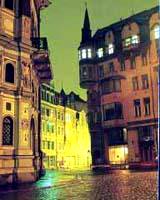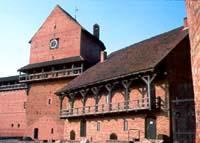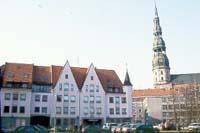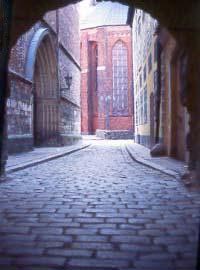A little bit further, close to the Daugava, the second Liv settlement
appeared - the fishermen's one (in the area of Marstalu and Brivibas
streets). These two settlements were connected with castles of Livs and
Latgals and settlements of craftsmen situeted at the second most important
river - the Gauja - by the only ground road - the Sand Road.
And on one autumn day guets arrived to bishop Albert. They were chiefs of
Livs from castles upon the Daugava River and Turaida region who had been
christened. When the feast was at its peak the bishop secretly ordered to
close all the outer doors and windows. After that he declared to the invited
that they were his captives and unless they yielded to his will they would be
shackled and sent to exile. And bishop Albert demanded the land near Riga
settlements to be given to him and his people. Having received the promise
bishop set chiefs of Livs free. But he took thirty sons of the chiefs as
hostages and brought them to Germany. That was how the building of Riga
had been started.
 The small Riga River wound like a narrow ribon along
marshes and sands and flowed into the Daugava River. Near the river's
bend a settlement of Liv merchants and craftsmen was located (in the
area of present day Audeju and Kaleju streets in Old Town of Riga).
The small Riga River wound like a narrow ribon along
marshes and sands and flowed into the Daugava River. Near the river's
bend a settlement of Liv merchants and craftsmen was located (in the
area of present day Audeju and Kaleju streets in Old Town of Riga).
 They used to build low houses made of pine or fir logs with straw or
reed roofs and basements made of boulders os oak-wood wells. They
worked in smithies, built vessels, traded at the Market Square. Foreign
merchants who travelled by the Daugava River were frequent visitors
there.
They used to build low houses made of pine or fir logs with straw or
reed roofs and basements made of boulders os oak-wood wells. They
worked in smithies, built vessels, traded at the Market Square. Foreign
merchants who travelled by the Daugava River were frequent visitors
there. It followed the path of present-day Brivibas street and turned to Liv
settlement near the Powder Tower.
It followed the path of present-day Brivibas street and turned to Liv
settlement near the Powder Tower. In spring 1200 Pope in his bull declared crusade against Livonia peoples.
From that time more and more often foreign ships arrived to the harbour on
the Riga River - not with goods but with armoured knights. At last bishop
Albert arrived - with knights and squadron of 23 ships. for the whole
summer they negotiated with local elders and examined the harbour.
In spring 1200 Pope in his bull declared crusade against Livonia peoples.
From that time more and more often foreign ships arrived to the harbour on
the Riga River - not with goods but with armoured knights. At last bishop
Albert arrived - with knights and squadron of 23 ships. for the whole
summer they negotiated with local elders and examined the harbour.

|
|
Copyright © 1995-2025 |